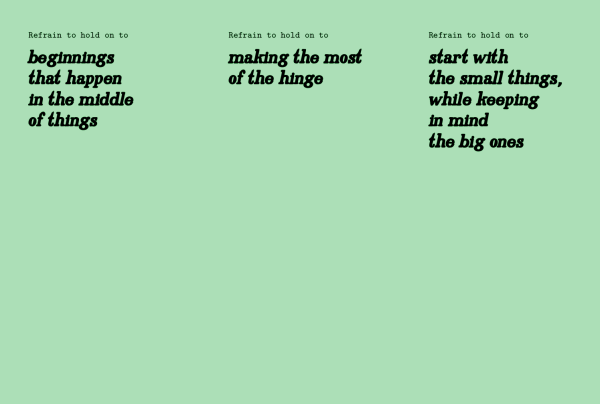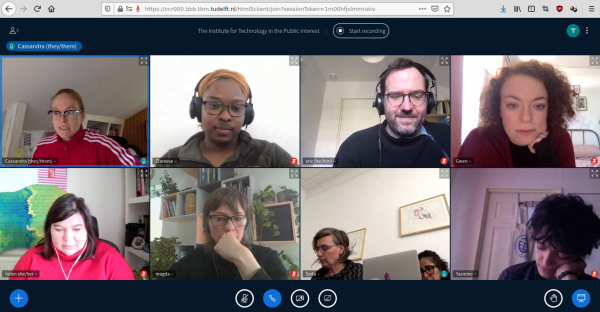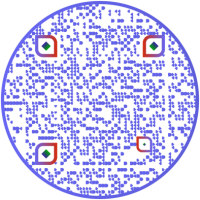Unfolding:Infrastructural Interactions
Infrastructural Interactions: Survival, Resistance and Radical Care
Index
Methods (or not) for Infrastructural Interactions
- Peripheral politics
- The Politics of Listening
- Bugreporting how-to
- Bugreport: When governments move fast and break things
- Infrables
Contributions
- From Critical Discourse Analysis to Word2Complex (contribution Varia, Miriyam)
- Infrastructural Manouevres (contribution Anita, Martino)
- Negative Infrastructures (contribution Joni, Gwen)
- Other Weapons Distro (contribution Cassandra)
- (contribution Peri + Neset)
- Yasmine Boudiaf, Listening Structures
- Clareese Hill, Impossible Breathing Meditation Praxis
Appendix
Methods (or not) for Infrastructural Interactions
Infrastructural Interactions: Survival, Resistance and Radical Care
Cristina: Even if the infrastructure fails, there's all this imagery around it that connects to progress, ideas of progress, and ideas of modernity and that has a lot of rhetorical power. I think thinking about other ways politics or other ways of interacting with, of building an image around infrastructures is really valuable, actually. At least, for me, the most convincing that I've encountered, I don't know.
Clareese: Definitely, yes. I do agree too. Infrastructure or the idea that it's not going away, so how do you use it and make it useful to the people that it's supposed to act as a container or a boundary around?
Radical Care
As public health care nearly collapsed under pandemic pressure, schools closed and movement through public life became increasingly monitored and managed by digital infrastructures, we have been thinking with other collectives about radical alternatives to the need for care. For the last two decades, basic care provisions have been turned into tools that perform racial capitalism, excluding and punishing those who needed it most. What kind of solidarity and support can people extend and receive to one another that is outside the scope of the limits that are being imposed on us, from the voluntary duty of care to not expose one another, to a state supported obligation to function as a subject to capitalism? The fact that the pandemic made it impossible to come together physically to organise and to resist, triggered many discussions and reflections. When lockdowns immobilised a lot of the practical options that common people and ordinary working-class people have for resistance, which would be their bodies and the street, or meeting to make plans or to provide care for each other, cloud infrastructure has often been presented as the way forward — such as hosting organising over Zoom, using Google Drive to distribute materials or Uber to distribute care packages.
For the conversations and workshops that feature in this manual, we brought together people involved in alternative healthcare or other alternative care-structures, for example in the context of anti-fascist activism, or groups rethinking alternative technical infrastructures in terms of capacity and care. Without wanting to turn everything into infrastructure, we felt it was helpful to open up perspectives that point out the worlding qualities of caretaking, maintenance and instituting.
From survival to resistance in racial capitalism
As people who are active on the ground, but also intellectually, what do we imagine in terms of resisting and building alternatives for or to cloud infrastructures? What are our lived experiences with infrastructures that demand these alternatives? A question that came up often in our discussions and practices was whether this is a time of survival, or a time of resistance? Are the creative imaginaries we are exchanging, an example of resistance ... or are they actually about just surviving? We were interested in asking this question, because we know that people are sometimes using extractive services and apps, knowing very well that it's a risk, and that by using them, they're actually being exploited even more.
In the workshops, conversations and collective writing that generated this workbook, we have tried to think resistance under racial capitalism and issues around extractivism with participants from different geographies and practices. What are the material aspects of cloud infrastructures that are being imposed on us, during COVID-19 lockdowns and since? It felt these questions where erased from the debate, even among critical scholars working on technology, while obviously racial capitalism and extractivism are part of the conversation. This workbook brings attention to the ways in which computational infrastructures extend extractivism, from the mining of rare minerals for smart phones to the extractivist models of cloud-based services and the extension of Big Tech into the markets of care. To do so, we build on a body of literature pointing out the continuing geopolitical make-up of imperial and colonial power in the development of infrastructural technologies. In particular, Syed Mustafa Ali argues for a decolonial approach when designing, building or theorizing about computing phenomena and an ethics that especially decentres Eurocentric universals.[1] Paula Chakravartty and Mara Mills offer to think decolonial computing through the lens of racial capitalism.[2] Cedric Robinson argues that mainstream political economy studies of capitalism do not account for the racial character of capitalism or the evolution of capitalism to produce a modern world system dependent on slavery, violence, imperialism and genocide.[3] Capitalism is ‘racial’ in the very fabric of its system.[4]
The work documented in this workbook is embedded in a view that requires continuous undoing – a necessary but unfinished formal dismantling of colonial structures by decolonial resistance. Building on theories of racial capitalism, we focus on the implications of computational infrastructures and their relation with extraction, whilst working on ways to develop a non-extractive research practice.
What does Cloud infrastructure do?
Cloud infrastructures purposefully promote data intensive services running on the infrastructures, rather than pre-packaged and locally run software instances. These data-infrastructures range from health databases, border informatics, data storage warehouses, to city-dashboards for monitoring citizen flows, educational platforms and the optimisation of logistics. It has become common for theorists, activists, artists, designers and engineers that want to critique cloud services, to focus on the way they extract data from individuals, either for value or surveillance, or to automate services so that institutions can reduce workers rights or employ less people. The research we are doing at TITiPi however evidences quite clearly that this might not be the best way to understand what clouds are and how to resist and prepare for the massive shifts in public life they are and plan to make.
Instead, we propose that what we need to look at how Big Tech cloud services are financialising literally everything on a rentable model, thereby indebting institutions, communities and individuals to their values and services. Cloud infrastructures offer agile computational infrastructure to administer, organise and make institutional operations possible, decreasing the potential for institutions to manage their own operations, locking them into a cycle of monthly payable subscription agreements (debts) and rendering all operations from emptying bins, to paying bills, to hosting collaborative documents ready to be financialised by Big Tech cloud companies. They do this by promising a future of being able to fullfill the operations that institutions themselves might not even have imagined. By interfacing between institutions and their constituents through Software-as-a-Service solutions, they reconfigure the mandate of institutions and narrow their modes of functioning to forms of logistics and optimization.
As Big Tech extends into public fields, they tie together services across domains, creating extensive computational infrastructures that reshape public institutions. So the question is, how can we attend to these shifts collectively in order to demand public data infrastructures that can act in the "public interest"? And how can we institute this? Computational infrastructures generate harms and damage beyond ethical issues of privacy, ownership and confidentiality. They displace agencies, funds and knowledge into apps and services and thereby slowly but surely contribute to the depletion of resources for public life. While data- infrastructures capture public data-streams, they also capture imagination for what a public is, and what is in its interest. We urgently need other imaginations for how we interface with infrastructures, beyond delivering a “solution” to a “need” (or the promise they can fulfill a future need).
The workshops, documentation and structures in this workbook are a small contribution to making this complex paradigm shift together.
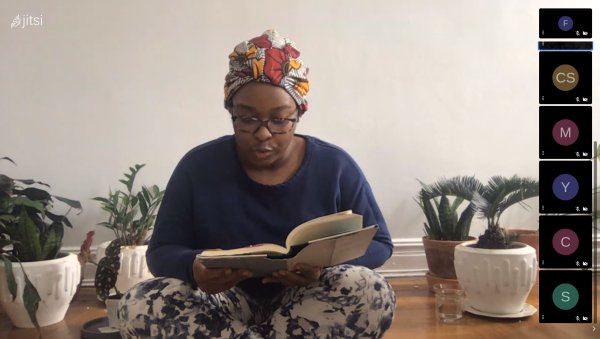
Peripheral politics
A workshop with Helen V. Pritchard and Femke Snelting
"As such, urban politics will largely be a peripheral politics, not only a politics at the periphery, but a politics whose practices must be divested of many of the assumptions that it derived from the primacy of 'the city'.”[5]
During this on-line session, we worked with eight conversations on infrastructural shifts that TITiPI had organised with companions in the months before. To attending to the stories that were told and the surprising details that came up through the rhythm of three refrains, was an attempt to listen for the experiences of living with infrastructure but also for other worlds of radical care and different temporalities not defined by Big Tech infrastructure nor by academic methods, worlds that are already here, that are already being practiced.
In this workshop, we tried not to fall for the suggestion of a coding or analysis that might make sense of transcripts from the outside, we listened together to generate a poetic-theory of infrastructure. We generated an understanding that was feeling into the surges of life, or what AbdouMaliq Simone calls "the rhythms of endurance with infrastructure".[6]
We borrowed the idea of 'refrain' from Kara Keeling who suggests that we need to be attentive to another world that is possible because it is already here.[7] Sensing the different organizations of things, different systems of signification and value, so much so that it might give way to the another world. Sung in the refrains with other temporalities and coordinates, yet already here.[8]
Perhaps this world gives way in the peripheries, AbdouMaliq Simone reminds us of the importance of what he calls a 'peripheral politics', of a-centric practices and rhythms: "[s]urges of rhythm emerges from attempts to reach beyond the confines of limited places and routines, and yet retains a microscopic view of the constantly surprising details about the places that could be left behind".[9]
The workshop 'Peripheral Politics' was a way to organise and categorise research material not based on the extraction of meaning but on the collective listening and responding-too through a set of interconnected prompts. The transcriptions opened up onto urgencies, repetitions of stories, giving ways to other worlds, partially told.
Peripheral listening
- Hold a series of open conversations with companions and associates on a subject matter that is felt as urgent, but which is not yet fully seen or comprehended.
- Transcribe the conversations or ask a companion to do so.
- Invite everyone that participated in the conversation for a two hour workshop.
- To keep a shared rhythm whilst reading, propose a set of three 'refrains' as things to hold while reading, listening and responding to the material. These 'refrains' can be quotes, phrases or aphorisms that intuitively resonate with the transcriptions.
- Publish each conversation on an on-line notepad such as etherpad, or print them out on paper in case you are all in the same room.
- Split up in small groups (two or three people) and chose one conversation. In case of an on-line workshop, also open a channel by which you can hear each other. Many on-line video-services have a breakout-room feature but this adds a layer of efficient management that might be blocking the exercise.
- Choose together one of the refrains to hold on to.
- One person reads the conversation out loud while the others use the chat function to simultaneously associate, rhyme and respond alongside the conversation. For IRL, use pen and paper.
- Experiment with selecting parts of the interviews through a collective process that resisted more extractivist ways of coding, sorting and labeling.
- Create a series of poetic openings and peripheral attention in the margins of the transcripts by listening to to the material in this indirect way.
- After 20-30 mins, take a short break and change roles at least once.
- If you've got time, regroup and refrain another conversation using the same method.
- Come back together and discuss.
Refrain to hold on to: beginnings that happen in the middle of things
a little song, a nocturnal creation myth or ‘sketch’ in the middle [...]; it is not a genesis story of the logos and light, but a song of germination in darkness [...] I begin with it because doing so calls attention to the improvisational elements of any beginning, which always happens in the middle of other things.
Kara Keeling, Queer Times, Black Futures
Refrain to hold on to: making the most of the hinge
Here, the surge as rhythm emerges from attempts to reach beyond the confines of limited places and routines, and yet retains a microscopic view of the constantly surprising details about the places that could be left behind. This is a rhythm of endurance, of surging forward and withdrawing. It is not a rhythm of endless becoming nor of staying put; it is making the most of the “hinge,” of knowing how to move and think through various angles while being fully aware of the constraints, the durability of those things that are “bad for us” (Stoler 2016).
AbdouMaliq Simone, Improvised Lives
Refrain to hold on to: start with the small things, while keeping in mind the big ones
Any "archipelagic" thought is a trembling thinking, it is about not-presuming, but also about opening and sharing. We do not need to define a Federations of States first, or to install administrative and institutional orders. It already begins its work of entanglement everywhere, without being concerned with establishing preconditions. As far as our relations in the Archipelago are concerned, let us start with the small things, while keeping in mind the big ones.' (Toute pensée archipélique est pensée du tremblement, de la non-présomption, mais aussi de l'ouverture et du partage. Elle n'exige pas qu'on définisse d'abord des Fédérations d'États, des ordres administratifs et institutionnels, elle commence partout son travail d'emmêlement, sans se mêler de poser des préalables. S'agissant de nos rapports dans l'Archipel, commençons par les petites choses, tout en ayant en l'esprit les grandes.)
Edouard Glissant, Traité du tout monde
Print out refrains: http://titipi.org/projects/infrastructuralinteractions/refrains.pdf
Transcript marginalia from the workshop
Refrain: "start with the small things, while keeping in mind the big ones"
- F: among the group is in your world
- F: everywhere ceasing the moment
- F: many chats i am in
- F: multiplicity access points
- F: distributing power
- F: (i am losing your voice...)
- F: a secret account
- F: not a time of purity
- Y: you are assigned a character
- Y: make the best of what was around
- Y: repurpose tools
- Y: continue gathering despite restrictions
- Y: staying connected to the community
- Y: think about who else may benefit from resources
- Y: recurrence, word of mouth gives rise to solidarity
- F: starting a month after
- F: confused joining, solidarity based on that
- F: a union with new people starting on chat
- F: it starts with someone needing a hammer
- F: it starts with someone needing a test
- F: it started with people having trouble paying rent
- F: it started with things that did not stop
- F: it started on tuesday
- F: a chat and doubt
- F: releasing documents
- F: organizing that starts with a stat
- F: chat
- F: it starts with breaking up
- F: intensity of seeing the fascists (not) go
- F: tech and having time
Refrain: "making the most of the hinge"
- H: waves of the lunch break
- H: closely connected
- H: what technology does in a particular situation
- H: not the generic one
- H: ongoing work
- H: being between many projects that are close too
- H: processing ways
- H: vernacular play
- H: collective moments of togetherness
- H: collective infra.. the act of doing
- U: hinge: capacity/ongoingness/different frames
- U: they get funds for doing ceretin kind of work
- U: on the one hand
- U: on the other hand
- U: not really a coincidence
- U: exchanging ways tactics for refusal
- U: at the same time have been really amazed
- U: they are just right at surface
- U: even though we don t see them
- U: are we funding these interactions
- U: feeding back into funding
- U: ////
- H: --live experience of the hinge--
- H: --reshaping one hinge into another---
- H: not a conincidence
- H: contradictions come with it
- H: if you decided to be the displacement between different places. people, you maintain this there is always contradictions you are holding onto something
- H: working as a hinge
- H: bringing it up
- H: rather than being an underground hinge
- U: different infrastructures were the hinges
- H: carries weight to make the movement possible
- H: out of proportion movement possible
- H: //////
- H: our relationships
- H: shock level
- H: shock crisis
- H: looking out for each other
- H: confidence of fascism
- H: ---
- H: spending money and how it creates oppositional to your wellbeing
- H: the school, the funding,
- H: how close to supporting this movement
- H: chicken sandwiches
- H: chickfill a funding inserruction
- H: where is my money being spent going
- H: to the radical institutions that work against me
- H: this moment has made everyone stop and consider where the money
- H: --- through the chicken s/w story---
- H: the hinge becomes visible
- H: by making it into a story you are making the most out the uncovering the hinge
- U: a lot of work lately, this mic
- U: there is no real prescription
- U: training in on sylvia winter
- U: (AI)
- U: these walls are problematic now with COVID
- U: we also need
- U: making people comfortable
- U: have to do something either way
- U: maybe classroom is the garden
- U: sylvia wynter is the hinge
- U: making the most of something
- U: even though crushed in this hinge
- U: we are gonna have to do something
- H: Sylvia Wynter as the hinge
Refrain: "making the most of the hinge"
- H: it seems important the awareness of the constraints
- H: as that isn't always there
- H: organsiing through fb there is a degree of accepting the problematic parts because the trade is neccessary
- H: it comes with a frame that might twist against you
- M: hinge that can empower to think beyond the frame/constraints?
- H: being aware that whilst looking through the different angles
- M: in this case fb is the frame, oraganizing is the hinge
- M: taking care of eache other during the demonstrations
- M: doing the right thing partially
- M: close to each other
- M: different ways of doing food distributions anyway
- M: big lineups outside
- M: everymorning a good morning
- M: daily hope og trying to keep hope alive
- M: started basic stuff
- M: impressed by the tenacity
- M: people were not allowed to gather
- M: and they did it anyway in didferent ways
- M: managed to do it in a way that was respectful
- M: deliver food
- M: families who couldn't make it or who had quite a lot
- M: emojis are undervalues [laughs]
- M: they have not given up on their families
- M: outside the scope of the state because it was needed
- H: not hiding for what is the basic keeping in touch
- H: sending hearts as a daily refusal of the state
- H: included laughter
Refrain: "beginnings that happen in the middle of things"
- F: always with these things
- C: angled points
- F: already important
- C: complicit kinship
- F: waiting not waiting not to be repatriatiated
- C: implicit level of technology
- F: accelerated means able to organise
- C: own lived experience with technology (as a shifting, trembling thing)
- F: being exposed to
- F: since it arrived it shifted it is different
- C: shifted by the pandemic
- C: crisis as a moment to atomise that does not lead to resistance
- F: when it is like that there is no resistance
- F: when it happened here
- C: similar things happening in other parts of the world
- F: when it happened in other places in the world
- F: when it happened on the street
- ↑ Ali, S. M. (2016), ‘A brief introduction to decolonial computing’, XRDS: Crossroads, The ACM Magazine for Students, 22:4, pp. 6–21.
- ↑ Chakravartty, P. and Mills, M. (2018), ‘Virtual roundtable on decolonial computing’, Catalyst, 4:2, p. 14
- ↑ Robinson, C. ([1983] 2000), Black Marxism: The Making of the Black Radical Tradition, Chapel Hill, NC: University of North Carolina Press
- ↑ Bhattacharyya, G. (2018), Rethinking Racial Capitalism: Questions of Reproduction and Survival, Lanham, MD: Rowman & Littlefield.
- ↑ AbdouMaliq Simone, Improvised Lives (Polity Press, 2019)
- ↑ Simone, Improvised Lives.
- ↑ Kara Keeling, Queer Times, Black Futures (New York: New York University Press, 2019).
- ↑ "The generative proposition another world is possible, the insistence that such a world already is here now and it listens, with others, for the poetry, the refrains, the rhythms, and the noise such a world is making." (Keeling, Queer Times, Black Futures)
- ↑ Simone, Improvised Lives
The politics of listening
A workshop with Miriyam Aouragh and Seda Guerses
For our second round of approaching the conversations, we applied Critical Discourse Analysis (CDA), again only involving companions that had been part of the conversations to begin with. As a way to decolonize our listening practice, Miriyam proposed a set of questions to ask while listening. This reflective methodology or reflexive ethnography was based on questioning the self, its power relations, its expectations and biases.
The “politics of listening” workshop was an inductive process of bottom-up interpretation, through making a socio-semantic inventory. Taking que from Decolonial Methodology, we felt that doing the research entails to give back to the phenomena or communities we study, which means that we not only take into account who pays for this research but also what purposes the research serves.
Our engagement with Decolonial Methodology was manifested in the way we designed the workshops, which themselves are entrenched in an ethical relationship between the researchers and researched. Our approach assumed accountability and therefore the research project had to involve reflection and reflexive writing which takes into account our own positionalities and biases. In this workshop we particularly played with the intersection between language and power, proposing to experiment with relation our own communications to politics. A politics of representation and the influence of subtext can come together in many ways, but few are as comprehensive for methodological interpretation as CDA.
CDA as a methodology emerged as an anti-racist method to delineate the discursive practices and linguistic features that construct the representation of social actors. We used its basic tools to apply it as a form of critical listening because CDA goes beyond classifying words and calculating common features. Instead the C = critical explicitly refers to its non-neutral agenda, which is meant to contribute to the change of a social reality by uncovering (with the intention of undoing) gendered/racialised/economic power relations and mind-sets:
- Gender/race/disability are predominantly assigned passive roles, but besides white/male/abled/middle class, also technology is ascribed with active disposition;
- Analysis about technological progress mostly foregrounds structure over agency, and machines over humans
- The moral framework or ethical scaffolding of a conversation can become clear when we unearth who are the most represented or the predominantly invisibilized actors in the discourse/writings/recordings.
It became clear that the speech pattern of circularity and friction was a way to hold together the conflicts and contradictions, and that this was part of understanding struggle. It made us wonder how to hold the concepts in relation to the experience that were being described, which feels necessary to then have an analysis of tactics and practice. We also discussed the implied linearity of the analysis, going from recording to transcript to memory, and how this might reinstate the figure of the expert interpreter after the fact.
An exercise in Critical Discourse Analysis
A collective exercise in critical reflexive decolonial orientations in listening. The exercise requires ca. two and a half hours, including a short break.
1. Split up in small groups (two or three people) and choose a conversation you would like to work with, and a channel to communicate.
2. Compile a list of terms that you think will appear in the conversation you are about to analyse. These can be common/expected/remembered terms. For example: infrastructure/technology, resistance/protest/activist, space/place, state, reactionary, capitalism/neoliberalism, racist/racism, funding/finance/money, ability/disability/ableism, feelings. (10m)
3. Search and listen: use transcriptions (e.g., search through the text) and recordings as a way to locate the moment that these concepts and themes occur, and select one or two moments where the concepts are discussed during the interview. (30m)
4. Ask how these concepts were communicated in the conversation (30m):
- How is the concept valorised or qualified (.... is shit):
- positive/negative
- hopeful-optimistic/hopeless-pessimistic
- accepted/rejected ...
- What is their temporality (in past present or future tense?)
- Can you detect a speaking pattern (hesitant, circular, trailing, in-out?)
- How is it spoken about (your own criteria for listening):
- silence/void
- agitated/enthusiasm
- ...
5. Compare notes between groups. (20m)
6. Look at other conversations for similar concepts and redo the analysis with both conversation in mind. (20m)
7. Social analysis: Frame what you found in discussion with other groups; consider the infrastructural, political, economic context of what is said/claimed/proposed. (30m)
Bugreporting as a method
Bug reporting, the practice of submitting an account of errors, flaws, and failures in software, proposes ways to be involved with technological development that not only tolerates, but necessarily requires other modes of expertise than writing code. Bug reporting is a lively technocultural practice that has come to flourish within free software communities, where Linus’ law “with many eyeballs, all bugs are shallow” still rules.[1] The practice is based on the idea that by distributing the testing and reporting of errors over as many eyes (hands, screens, and machines) as possible, complex software problems can be fragmented into ever smaller ones. By asking users to communicate their experiences of software breakdowns effectively, bug reporting forces “the making of problems” through a process of questions and fragmentation.[2] It exposes so-called bugs to a step-by-step temporality, to make even the hardest problems small enough to be squeezable,[3] as they eventually are reduced to nothing more than tiny bugs.
In order to streamline the process of such squeezing, many software platforms have been developed to optimize the cycle of bug reporting and bug fixing.[4] “Issue trackers” help developers to separate bug reports from feature requests. A “bug” is a fault or an error that responds to what is already there; a “feature request,” on the other hand, is a proposal that adds to the project-as-is; it extends an existing feature or ultimately necessitates the rethinking of a software’s orientation. It is obvious that in such a technosolutionist framework, reports will attract attention first, while requests have a lower priority. Once identified as such, a bug can then be tagged as “critical” (or not), assigned to a specific piece of code, a software release, a milestone, a timeline, or a developer who then will need to decide whether it is a syntax, run-time or semantic error. From then on, the bugs’ evolution from “reported” to “resolved” will be minutely tracked.
The issue with issue trackers and with bug reporting in general is that these are by definition coercive systems. Issues can only be reported in response to already existing structures and processes, when “something is not working as it was designed to be.”[5] But what if something (for example, in this particular case, a geocomputation toolkit) is not designed as it should be? Or even more importantly, what if geocomputation should not be designed, or it should be actively undesigned and not exist at all? Or what if there were no way to decide or define, in advance, how something should be without making an authoritative gesture of prejudgment and imposition?
Bug reporting tightly ties users’ practices to the practice of development, making present the relations of software––it is a mode of practicing-with. Like Haraways’s situated practice of writing, figured by Maria Puig de la Bellacasa as a “thinking-with” and “dissenting-within”, bug reporting makes apparent that software does not come without its world.[6] Dissenting-within figures as both an embedded mode of practice, or speaking from within open-source software, problematizing an idea of a critical distance; but also has an “openness to the effects we might produce with critiques to worlds we would rather not endorse.”[7]
From: The Underground Division (Pritchard, Helen V., Rocha, Jara and Snelting, Femke) “We Have always been Geohackers.” In Volumetric Regimes: Material cultures of quantified presence, edited by Possible Bodies. Open Humanities Press, 2022.
Reports by The Institute for Technology in the Public Interest: bugreports
EU Digital COVID Certificates: When governments move fast and ...
EU Digital COVID Certificates: When governments move fast and break things
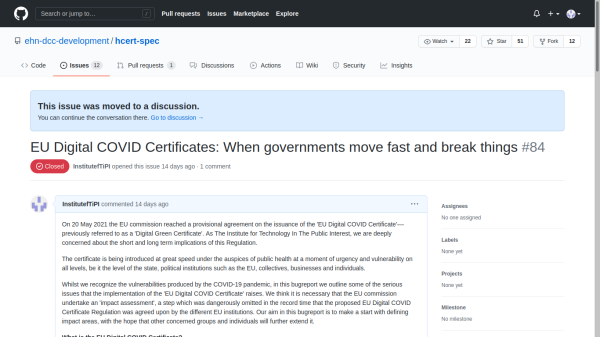
On 20 May 2021 the EU commission reached a provisional agreement on the issuance of the 'EU Digital COVID Certificate'––previously referred to as a 'Digital Green Certificate'. As The Institute for Technology In The Public Interest, we are deeply concerned about the short and long term implications of this Regulation.
The certificate is being introduced at great speed under the auspices of public health at a moment of urgency and vulnerability on all levels, be it the level of the state, political institutions such as the EU, collectives, businesses and individuals.
Whilst we recognize the vulnerabilities produced by the COVID-19 pandemic, in this bugreport we outline some of the serious issues that the implementation of the 'EU Digital COVID Certificate' raises. We think it is necessary that the EU commission undertake an 'impact assessment', a step which was dangerously omitted in the record time that the proposed EU Digital COVID Certificate Regulation was agreed upon by the different EU institutions. Our aim in this bugreport is to make a start with defining impact areas, with the hope that other concerned groups and individuals will further extend it.
What is the EU Digital COVID Certificate?
The EU Digital COVID Certificate depends on the establishment of a digital token that links to an individual, 'a holder'. It is proof of either vaccination status, testing status or whether someone has recovered from COVID-19. Setting up a digital token requires infrastructural support, which connects digital with administrative infrastructures. Such an infrastructure is needed to digitally issue certificates and ensure authenticity of each certificate. The certificate can be carried on a mobile device or as a paper document. It makes it possible for different 'verifiers', such as public authorities, travel operators, venue owners or organizers of gatherings, to establish whether the certificate is authentic; if it belongs to the 'holder'; and if it carries the value necessary for entering a space, participating in an activity, or crossing a border. For the verification to happen in a rapid manner, the certificate uses a QR-code signed by the authorities. This means the 'verifier' needs to use a digital device, such as a smart mobile phone or QR code reader, to confirm the veracity of the certificate.
We argue that the implementation of these different steps represents a shift towards administrative-infrastructural regimes. Regimes that are made possible by digital infrastructure and their operational logics––with significant short and long term consequences.
Re-purposing e-health infrastructure for managing freedom of movement digitally
Many public health systems in Europe are not fully digitized. However, the introduction of the digital certificate catapults them into the realm of digital administration on a scale never implemented before. This shift to administrative-infrastructural regimes implies the reorganization of public health, as it changes the trust and power relations between relevant actors and stakeholders. The proposed system goes far beyond digitizing health records and existing workflows, because it introduces a system through which "certificates" can be used to manage every day activities, specifically freedom of movement. Public health authorities are typically not responsible for setting policies and running digital operations which regulate people's movements. In addition, digital infrastructures can come to reconfigure or even break public institutions, as exemplified in the way journalism and publishing succumbed to the rise of social networks like Facebook. What impact does it have on the public health system, its objectives and responsibilities, to be repurposed in a digital environment for the issuance and verification of certificates? What mechanisms are in place to capture and respond to the potential risks of digital transformation of public health institutions at this scale and speed?
Growing public private interdependencies entrenched in an essential infrastructure
While any vaccine or test can be written into a certificate, not any test or vaccine will fulfill the requirements for freedom of movement. By virtue of regulating which test and which brand of vaccine can allow the holder of the certificate to enter a space, participating in an activity, or cross a border, the EU Digital COVID Certificate will act as a powerful gatekeeper between private partners, governments and the public. How is the growing interdependency between public and private agents being kept in check that is part and parcel of this essential infrastructure?
Policing will bleed further into daily life
Since the data in the QR code is available in the clear, this infrastructure has no built-in constraints for who can verify the certificate. Since certificate checks can be expected not only at the border but could be easily implemented for entering a workplace, a demonstration or a classroom, it introduces new forms of policing into every day life. This set up facilitates conditions of vigilantism through the everyday management of citizen movement, optimisation, population flow and control. It also potentially demands teachers, health-workers, shopkeepers and protest organisers act as if they were police. What mechanisms are in place to limit random checks? What legal and complaint procedures are foreseen to address grievances? How to ensure that rather than supporting freedom of movement, the digital token becomes a tool to restrict movement of people as they go about their daily life?
The expansion of borders
As argued above, the implementation of the certificate will further intensify technologies of the existing border regime into everyday life, also at places that are far from geographical borders. It extends the force of the state, which will no doubt add to histories of inevitable inequalities and asymmetries of such bordering regimes. The EU itself has a terrible track record when it comes to border regimes, human rights and global inequities. What is being done to prevent the certificate from further contributing to racist, classist systems, to a multi-tier society and increasing levels of violence at ever expanding borders? How does the regulation consider people from outside of EU and the way their human rights might be affected by the introduction of digital certificates?
A neverending infrastructure
The recent renaming of the certificate from a generic 'Green Digital Certificate' into 'EU Digital COVID Certificate', seemingly limits its scope to the COVID pandemic. But as we know from the USA PATRIOT Act that was introduced short after 9/11 and never fully retracted, or anti-terrorism measures in France that were extended five times, once in place––when dependencies are created, "crisis measures" risk becoming permanent. Although the Regulation has attempted to address this concern by including a clause that deals with rollback by stating that it "should be lifted as soon as the epidemiological situation allows", this does not guarantee it is just a temporary measure. With multiple industries and countries depending on the relaxation of the lock downs, and technology companies of all sizes entangled in this digital-administrative-infrastructure, what force will it take to remove it? Is the 12 month sunset clause still valid when the COVID-19 pandemic has not been overcome by that point? What prevents its application be resumed in case of another pandemic due to an outbreak of SARS-CoV-2, a variant thereof, or similar infectious diseases with epidemic potential?
Shifting grounds
The fact that this certificate is in essence digital, makes it possible to introduce regular updates. This will make the infrastructure responsive to changing understandings of the effectivity of vaccines, and new test methods to be integrated. The Regulation limits clearly what can be certified: vaccine, test result, and recovery, but it does not regulate what policies can be applied based on checking the information carried on the certificate. The policy determines whether a given vaccine or test is sufficient for movement, or whether there are exceptions or updates to policies that should be applied. The certificate is promising to not discriminate between recovery, vaccination or a negative test. How is the equivalence between the three, vaccination, testing and proof of recovery maintained? Who decides what prevails or what happens when scientific insight changes?
This bugreport ended up in the Github repository of the Digital COVID Certificate, because we have not found another platform to place it. The promise of a timely digital solution for re-establishing freedom of movement before the start of the summer holidays has erased the space for due diligence and public consultation. Given the concerns we raised above, and those raised by many other people and institutions, we are concerned that instead of a benign and 'safe' way out of a difficult situation, the EU Digital COVID Certificate will do immediate and long-lasting damage, especially since it is being rolled out as nationalism and fascism are on the rise in the EU and elsewhere.
We urge people in different communities, movements, professions, and institutions to consider extending the questions above, because absent of public consultation, and considering the potential impacts listed above, our main questions are: Can we afford this digital-administrative-infrastructure? Can we allow it? Is it really an option?
The Institute for Technology in The Public Interest,
Miriyam Aouragh
Nishat Awan
Gwendolin Barnard
Yasmine Boudiaf
Seda Gürses
Clareese Hill
Infrastructural Manoeuvres
Martha Poon
Helen Pritchard
Femke Snelting
Eric Snodgrass
Cassandra Troyan
Magdalena Tyżlik-Carver
May 28, 2021 https://github.com/ehn-dcc-development/hcert-spec/issues/84
Infrables
A workshop with Varia and The Institute for Technology in the Public Interest
Infrables make negative use-cases and un-fixing bug reports as a solidary praxis. They are articulations of what extractive digital infrastructures are, and what they are doing. What infrables can we tell to take-down Big Tech narratives and undo their violences? Generated through narrative and extra-narrative accounts, infrables identify oppressive infrastructures or tools, but they also make space for other technological attitudes.
How can we follow and understand infrastructural shifts through shared experiences? To what extent do individual experiences stand for a larger whole? What happens when you share, retell, adapt, rewrite someone else's experiences?
For a growing collection of Infrables brought together in different contexts, see the booklet here: https://titipi.org/pub/Infrables.pdf
Part 1: Infrastructural anecdotes
- Bring an instrument. Maybe you find yourself in a room with a guitar. Or some pots and pans or any other set of objects that can make variable noise.
- Pick a few anecdotes from the collection and read them out loud. One or more listeners accompany the readings with dramatic sound effects.
- Once the reading is done, work in small groups and tell each other a story or anecdote of an experience involving a digital infrastructure. Take 10-20 minutes to transcribe; give each anecdote a title
- Pick a few anecdotes from the new collection and read them out loud. One or more listeners might accompany the readings with dramatic sound effects.
Part 2: From anecdote to infrable
- Form groups of 3-5 people.
- Each group picks an anecdote. You can also mix several anecdotes.
- Gather on an etherpad page if remote, or meet around the table if your infrable-session is IRL.
- Choose some elements, and a format (see below).
- Re-write/change/re-tell the infrastructural anecdote into an infrable together.
- Pick several anecdotes from the collection of anecdotes and read them out loud. One or more listeners accompany the readings with dramatic sound effects.
Infrabling elements ✨
- Make the intention (instead of the "moral") of the story explicit: what is the intention for the "public interest"?
- Introduce a maxim, "concise expression" or motto
- Introduce fictional agents, such as talking plants, inanimate objects or other creatures (e.g.: the tortoise and the hare, grasshoper and the ant, etc.)
- Make space for natural phenomena, machinic agencies, other animacies
- Scale the timespace of the story
- Infrastromorphise (instead of antropomorphise) agents: attribute infrastructural characteristics, motivation or behavior to inanimate objects, animals, or natural phenomena
- Use rhyme, rhytmn and repetition to rewrite/retell the anecdote
- ...
Formats
- A drawing
- A shared BigBlueButton whiteboard
- Some pad writing
- A spoken story
- A song
- A poem
- A fiction
- A slogan/T-Shirt
- ...
Infrastructural anecdotes
Hanging there
When I arrived here at Rotterdam I remembered a friend of mine from long ago was living here somewhere. I have shut down my Facebook a few years ago but I had to reopen it cuz I had no other way to get in contact with her. When I did it, I found my profile intact, outdates and it creaped me out, but worst was to see and decide if I should read or not old messages from friend and colleges, job offers, favors and happy birthdays hanging there unanswered. I left as soon as I could.
What if I was not fit?
I remember that every time I wanted to register for a COVID test via the website I would always get options to get tested in random places, often far away from where I live. That was despite the fact that I marked the option that I cannot get there by car. Even though I did not always feel fit to get to the test location, I am a young and able-bodied person. I kept wondering what happens if you are not as fit? Why were there no more options presented? it was different when you registered for a test by phone.
Sentimental download
A best friend from high school passed away many years ago. We both used Xanga as a blog/journal during our high school years, and used the private messaging system essentially to joke at eachother back and forth - empty chats. Xanga messaged me when they were shutting down in probably 2014... or earlier? asking if I wanted to download the text code of my page. I did, and in the bundle was also included my and Stephanie's private correspondences, hidden comments, hidden posts. This is a moment of tension, perhaps grief (two years after her death), but also sentimental.
Check-in
The phone I use is quite old and so I could not download the national tracing app. I therefore could not access some locations as I could not "check in" digitally. This was during the first lockdown, but it seems that since then venues have been told they could not discriminate against people without the app and to offer alternative (paper) check-in processes.
Faceless
In the work that I do the organisation uses Microsoft Teams. In the first meetings we had I didn't want to install the app or program on my laptop, and so I joined straight from browser. It took me some meetings to realize that that was the reason why I couldn't see my colleague's faces, because the software allows you to see other people's faces only if you install the program.
Domestic vulnerability
Out of curiosity and of enthusiasm, I am running a small chat network from the meter box in my home. It actually is connected to an electricity plug right under my bed, so sometimes when I hover the bedroom and I touch the plug, the whole network goes down. A small form of domestic vulnerability. But anyway, the network runs most of the time.
Lost letter
My flatmate received COVID support during the early months of COVID, since she was unable to work in either of the two jobs she had. She applied for it, unsure about the conditions, even though she was fulfilling the conditions. At some point we received a letter from the government that was unfortunately misplaced & buried under some newspapers we receive from our neighbours when they are done with them. Because she hadn't seen the letter within 2 weeks and because she hadn't responded she had to give back the entire sum. We assume the reason why the letter wasn't also sent digitally was to check if she was home during this time.
Overheated laptop
During the pandemic my laptop is suffering so much. It is getting a bit old (not even that old), but videoconferencing is so tough on it. I am not a professional participant in video conferences, not being able to use background images, sometimes accidentally logging off because my laptop got overheated.
Vaccine bro's
So people doing sexwork were saying to me, "do you have the vax badge on your profile", and then others were asking "have you seen the taglines on grindr", people are labeling themselves as big bear Pfizer, as Moderna otters, some said they saw a profile that was labelled, let me check it was ... yes: "Grindr profile of a “vaccinated top” with the foreboding caption, “It has begun.” It’s inevitable: the antibody bro is about to become the vaccine bro".
Corona 'Help'
With the first Corona aid, you could get 5,000 euros and there were people who got that. There were also people who took money fraudulently. That's why people had to give it back. Most of the people I know have actually transferred the money back. Because it is not clear at all. And there is so much stress. It's so unclear. You are being criminalised very quickly. People then immediately make a case of fraud. At the beginning it sounded as if it was available to everyone and you had to apply for it very quickly. You only had a certain amount of time to do it. I think it was 10 minutes or so and then the page closed. But the problem is, only if you received a number, you can get to this page, you've been waiting for days until you can get to the webpage. And I also have to confess, I didn't read the small letters, I just saw "I can get money". So they asked "Do you need more money?" and I of course said "Yes!". I wasn't entitled to that much help, because it was only for operating costs. But I didn't read the instructions. I was just trying to get my turn before Berlin said they had no more money. Because after that there was a time when it was stopped, because there was no more money. And now it's like this, you need to pay it back in one go. But it's not clear who pays back or not. And every tax advisor says something different about it. It's the same with friends. But then you are criminalised. As if you did it consciously. I was in such a panic because it was clear that we wouldn't get any money for 4, 5, 6 months, that at first I just clicked, I need money, I need money, I need money. But it's already true, the billions that are paid out to the big companies and what is then made out of these small amounts. It's all pure neo-liberalism.
Self-managing a demonstration on Eventbrite
So normally I try to participate in the 8th of March activities either go to march, or join a demonstration but this year it was not allowed to go out onto the street in groups. So I was looking on-line if there were any activities planned and then on one of the websites that normally has calls for the demos, there was an announcement that the organisers had permission for gathering a hundred people and that you would have to sign up on Eventbrite so that the tickets could be distributed. Actually, it wasn't Eventbrite, but I think for the story it doesn't matter. So I clicked on the link and of course all tickets were 'sold out', like already they were 'sold out', of course. So in the end I joined another activity and ended up on the same square on which these 100 ticketed people were supposed to gather. I realised they had blocked off with tape ten areas for 10 people to gather, and had rented metal barricades - the cattle thing, they had a made a circle with these barricades so inside there were these sections for ten people each so it meant that the organisers of the feminist or women's march had self organised this idea of checking who had signed into the Eventbrite, maybe they would have a barcode scanner at the entrance to this zoned off area. But what had happened is ... I had joined a less official feminist bike ride, we were so many we flooded the square so the whole setup crashed - people were crashing through the gates, broke the tape, there was a mess of bikes and people, it was a mess, there was no way the organisers could have kept with their promise of managing their crowd. So the worry about the barcode scanner being put in place, the fact that everyone participating in the official march had given their name, address and email, is really scary and the fantasy of becoming its own police force that the organisers held was really scary -- from the setup you could see they thought they could manage it -- and then the white punk girls just crashed it.
Spitting with couriers
I was traveling - trying to travel to Brussels to see my comrades and I was very anxious. I had ordered the COVID test and downloaded the app. There was a technological hitch and so it arrived two days late. I was anxious about the test not being testable, that it would be a non-viable sample, so I rang the company and they said "It is good to keep the sample as fresh as possible", and so I could book in a courier between 08:00 and 18:00, that would come and take my sample to the lab. But they could not give an exact time. As fresh as possible! They told me to wait until the courier arrived, knocked at the door and to spit into the tube whilst he waited. He arrived at 13h and knocked on the door and he waited while I watched the video, and spit in the tube. Wait, I had to go through the app stages. Open the tube, scan the barcode, watch the video, whilst he was waiting. I then sealed the sample and had to put it in a transparent bag that I handed over to him and at that moment we had eye contact, as I passed him my tube of spit. At that moment I thought: is he my nurse?
Infrables
┻━┻︵ \(°□°)/ ︵ ┻━┻
In the work that I do the organisation uses Microsoft Teams and Zoom, no it was Teams I think, whats the difference? In the first meetings we had I didn't want to install the app or program on my laptop, and so in first meetings I joined straight from browser, the Teams, or Zoom, house party, Jitsi or was I on Tiktok? I dunno... In the first meetings I was just staring at the icons, wondering why everyone was refusing the camera. In the first meetings even the head of the organisation didn't have a camera. In the first meetings I was still working but I gradually just relied on no camera too, taking the meetings from bed, from the floor, from wherever i felt the fuck comfortable. It started to really change the work I was doing, and i started to dream of the abolition of work, I mean before when we all had to sit in those team meetings and see each others faces, all encouraging each other too work. I mean I started to build like a beavers den or a like a badgers burrrow near where my desk would be, at one point I just took the desk broke it down, and burnt it outside. I mean I started to do my spreadsheets as if I was a beaver and before long I pretty much realised beavers don't care about spreadhseets. It took me some meetings to realize that that was the reason why I couldn't see my colleague's faces, because the software, that I think it was Zoom, or Jitsi, or was it that time i got invited to queer haus on mastadon no sorry it was Team I guess , allows you to see other people's faces only if you install the program. I had only Facetimed with my mom once a week until that day and she could see my burnt desk. You know when your mum answers the videocall and you still cannot see her face because the phone is so close to her face. what if I hadn't seen their straight faces for the last 12 months? - I think I rather not have seen my colleagues faces all semester, sleepy or full on make up on and showing of pajamas and eye bags, but mostly my own nap face was there. During the months of not seeing my colleagues faces, their faces slowly changed. After the installing, trading space on my device for faces, their motion changed. What ever happen to phone calls?! No file to safe after, no records, tracks... Im so paranoid this days, it really freak me out. I never got the invite for fucking Clubhouse. ◕ᴥ◕
Melting your CPU, one meeting at a time!
++++++++++++++++++++++++++++++++++++++++++++++++
Melting your CPU, one meeting at a time!
A stab in the dark at team building
__..--\
__..-- \
__..-- __..--
__..-- __..-- |
\ o __..--____....----""
\__..--\
| \
+----------------------------------+
+----------------------------------+
+++++ micro ++ soft ++ protest +++++
+ against the unequal distribution +
+++++ of terms and conditions ++++++
Join us in the blackout room!
++++++++++++++++++++++++++++++++++++++++++++++++
Proxy Power
Once upon a time, a device who was relied on heavily began to age. It took them longer to feel a tap, even longer (more forever) to use an app. And even worse, (access to THE SPACE denied)
Other phones that were also aging, had other issues but felt more and more annoyed and frustrated, so they met up one day for a big cup of coffee... With cracked screens and lint-filled ports, they decided together that they needed a new kind of power: PROXY POWER.
Characters:
- The Old device
- The Newer device
- The hero (a caring relative)
- The villain (state employee)
- The user (may or may not have covid)
- The space (the user is trying to access)
- The digital infrastructure
Addressable targets
"Addressable targets do not always receive what they deserve"
Contributions
From Critical Discourse Analysis to Word2Complex
Miriyam Aouragh, Manetta Berends, Cristina Cochior
To be added
Infrastructural Manouevres
Infrastructural Manouevres test scarytransclusions are coming [8]
Cite as: Infrastructural Manouevres. 2021. "TITLE". In Infrastructural Interactions: Survival, Resistance and Radical Care, edited by Helen V Pritchard, and Femke Snelting. Brussels: The Institute for Technology In the Public Interest. http://titipi.org/pub/Infrastructural_Interactions.pdf Negative Infrastructures Other Weapons Distro Contribution Peri + Neset
Listening Structures
Yasmine Boudiaf
Research in practice
I developed these listening sculptures as a way to provide a space for ideas to sit and develop during group discussions.
Part of my role as a research assistant in Infrastructural Interactions involved transcribing audio recordings. I was aware of what a typical audio transcription looked like, in terms of structure, punctuation and commonly used terms to describe audio phenomena. I wanted as much as possible to keep to good practice and to do my job well. And yet, on listening to the personal testimonies and conversations of the contributors, I became aware of my role as a form of censorship, that all transcribers participate in when making decisions on what should and should not be included in the final transcript. Whilst I included all the words that were said, I made editorial decisions to omit what are generally not considered relevant to the objective of the research task. The implication being that what is not included in the final transcript therefore has no value. I would contest that such omitted content has value beyond what is prescribed as relevant to a research task. I wanted to honour the omitted content and make visible the hidden emotional labour involved in such a task with a statement at the bottom of each transcript:
I apologise for omitting laughter, discourse markers and filler words. It’s not that they’re not valid, they are – they add colour and humanity to the conversation – they just don’t serve the purpose of this exercise.
Sincerely,
The Transcriptor
As a researcher within and outside academia, various restrictions are imposed on the way I practice. These explicit and implicit forms of control can originate form any one of a number of actors involved in the infrastructure of a research project, such as a funder, an academic institution, an agency, a principal investigator, a legal team, a finance administrator or a contributor. This can be quite frustrating, and I have found myself at times taking a positivist standpoint, of good academic practice, the implication being that genuine knowledge is there to be seized, if only rigorous systems were in place that captured as much content as possible, in as pure a form as possible. My 'hard sciences' background and English education are likely contributing factors to this way of thinking.
As I work to move away from a process of information control that assigns status to particular forms and sources of knowledge, and towards a decolonial, material-semiotic approach of knowledge co-creation that sees the actors involved in a research project as a web of relations where meaning is produced in that process, it becomes necessary to interrogate my own position in this system and how I behave as a researcher, in the projects that I participate in or design.
Being reflexive as part of my research practice means that I interrogate the way I do things and so am able to design new research processes. For example, my workshop series Entanglements[9] is a collective analysis of public-sector technology contracts, the output of which is a collage of writing, scribbles, images, memes and links that express the injustice (and absurdity) of the entanglement between a state powers and private tech companies in a way that a typical written report cannot. My ongoing collaborative authorship project AI Justice Matrix[10] invites the perspectives of practitioners concerned with the mechanics of knowledge formation that affect our relationship with technology. It treats all sources and expression of knowledge as valid and offers issues to consider when contemplating AI practice without necessarily offering an answer.
Reflexivity is particularly important when confronting the issue of power asymmetries inherent in researcher / participant dynamics. There may be group conversation, but the presence of the researcher means that the participants are under their gaze - it’s difficult to discern what effect this may have on the nature of the participant’s output.
Listening
Having a space that participants add thoughts to anonymously as they arise may help to reduce participants’ inhibitions.
What would listening look like when assigned roles were no longer visible, and participants were not confined by conversational dynamics (such as waiting for your turn to speak)? The listening becomes detached from any person yet at the same time, everyone becomes the listener, as each participant is presented with the output at the same time.
This distributed listening becomes active distributed listening when participants have access to the platform where contributions are collected and are able to manipulate them. These contributions, or thoughts, take on a life of their own; they are picked up and moved around by anyone, built on, manipulated and challenged. Half-formed ideas can manifest, and be made whole by someone else.
This side-system of qualitative data gathering adds value to a research project through capturing contributions that would have otherwise remained as thoughts in participants’ minds. It can also continue to exist beyond the lifespan of a research project, in acknowledgement that not all meaningful contributions can be captured in a prescribed session.
Using the Listening Structures
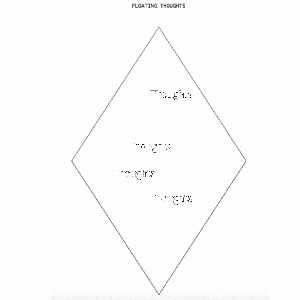
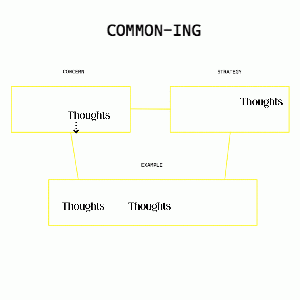
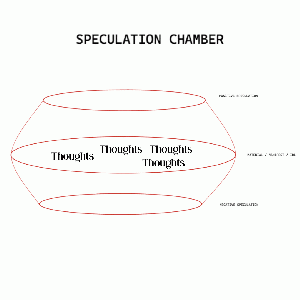
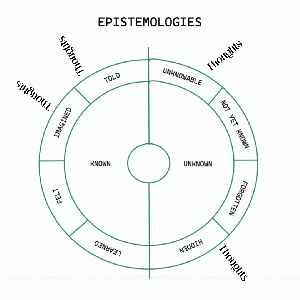
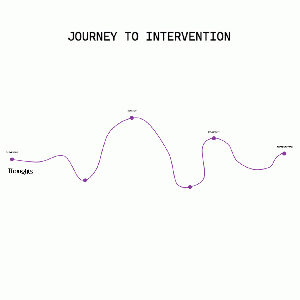
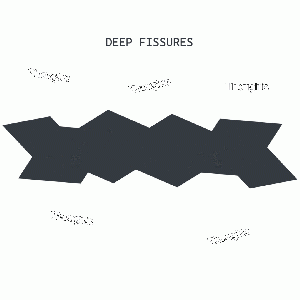
These are diagrams made of geometric shapes to aid in collective idea development. As ideas travel through these structures the nature of these ideas changes, providing a geometric framework for them to develop.
FLOATING THOUGHTS: A suspension of thoughts just existing.
COMMON-ING: Taking consistent themes, grouping them, making links between them.
SPECULATION CHAMBER: Taking real-world phenomena and imagining positive and negative versions.
EPISTEMOLOGIES: Displaying sources of knowledge and comparing their validity.
JOURNEY TO INTERVENTION: The path ideas take in order to produce meaningful interventions.
DEEP FISSURES: A space to acknowledge silences, omissions and redactions. For unvoiced thoughts and dismissed feelings.
The Listening Structures are drawn on a non-extractive collective drawing pad, Excalidraw. The original pad should not be edited, but rather a copy should be made and populated so that the original stays empty and useful to others, however, new, empty structures can be added to the original pad that others may find useful.
- Visit https://excalidraw.com/#json=6497964574900224,Ps6Si-EVmnSHpavjSZKVPg
- Click “Export”
- Click “Export to Link” (wait a while until there is a pop up window with a new link)
- Copy and paste the link into a browser window and edit your version of the structures as you like.
References
- ↑ Eric Steven Raymond, “The Cathedral and the Bazaar,” accessed July 1, 2019, http://www.catb.org/~esr/writings/cathedral-bazaar/cathedral-bazaar/index.html,
- ↑ As Simondon notes, “living is itself the generation of and engagement with problems.” Gilbert Simondon, L’Individuation à la lumière des notions de forme et d’information(Grenoble, Publisher 2013).
- ↑ In the context of technical bug reporting, squeezing refers to fixing.
- ↑ Issue trackers are increasingly being integrated into software versioning tools such as git, following the increasingly agile understanding of software development.
- ↑ “Bug: Definition—What Does Bug Mean?”, accessed July 1, 2019, https://www.techopedia.com/definition/3758/bug.
- ↑ See Maria Puig de la Bellacasa, “Nothing Comes without Its World: Thinking with Care,” The Sociological Review 60, no. 2 (2012): 197–216; Donna J. Haraway Staying with the Trouble: Making Kin in the Chthulucene (Durham: Duke University Press, 2016); and Kathrin Thiele’s chapter in this publication.
- ↑ Maria Puig de la Bellacasa, “Nothing Comes without Its World: Thinking with Care,” 205–206.
- ↑ gotta tell Ted
- ↑ UAL Creative Computing Institute (2021) Entanglements | Yasmine Boudiaf. Available at: https://www.youtube.com/watch?v=-dJbPW6ycbo (Accessed: 28 November 2021).
- ↑ Boudiaf, Yasmine 2021, AI Justice Matrix, accessed Nov 2021,https://aijusticematrix.com/
Cite as: Boudiaf. Yasmine. 2022. "Listening structures". In Infrastructural Interactions: Survival, Resistance and Radical Care, edited by Helen V Pritchard, and Femke Snelting. Brussels: The Institute for Technology In the Public Interest. http://titipi.org/pub/Infrastructural_Interactions.pdf
Impossible Breathing Modular Meditation Praxis
Clareese Hill
Welcome to a modular meditation praxis. This meditation consists of three materials that can be configured for the meditation you need at the moment. The first element is the meditation room, which is an immersive web space where the other two materials can be experimented with. The second material is the content for the meditation interventions. The content includes audio from seven singing bowls as they correspond to the seven chakras and poetic text by Black woman writers. The third material is the core meditation text which has moments for interventions of sound and poetic text. There is no order or prescription for how the meditations should unfold this is a space of poiesis.
1. The meditation room is where you can hold your meditation by bring the other three materials into that space. The meditation room is web virtual reality experience that is editable by watching the tutorial video found below under Mozilla Hubs tutorial. The meditation room can be accessed by the QR code or the links below.
- Mozilla Hubs Impossible Breathing Meditation Room: https://hub.link/Q6SDo39 This is where you can conjure your meditation. Mozilla Hubs Room code: 286185
- Mozilla Hubs Tutorial - Instructions on how to add the meditation interventions to the Mozilla Hubs meditation room. https://www.youtube.com/watch?v=5QnOsyyebEQ
2. Content for the meditation interventions: http://titipi.org/projects/impossible_breathing
3. Core text to be treated as fluid as water:
Impossible Breathing
Let’s take a breath
Let’s be still expect for our breath
Let’s let everything wash away with every breath
Inhale
Hold the air as breath, feel its contribution your body
Exhale
Let’s be slow together
Let’s meet in-between the inhale and exhale
Let’s meet in the air we hold as breath
Let’s image what it would be like to sit next to each other
Feeling each other’s energy becoming still
While we breathe together
Let your body go in this moment and the contiguous we will share together
Its’ no longer needed to be legible
Let the performance that the body is automated to engage in slows to a stop
We are connecting through our breathing
Being together through breathing
Feeling each other’s touch through breathing
A together that defies the constructs of reality
Insert Intervention
Let’s make right here right now abstract through breathing
Let’s participate in a contra-reality together that we conjure through our breathing
Let’s be there for each other and support each other with care through our breathing
Let’s think about meeting in-between the inhales and exhales
A liminal space that is unprescribed.
A multifaceted dimension of everything we need
Let’s take a journey of errantry together from the cosmos to under the surface of the water
Let’s learn together to practice impossible breathing
Breathing that happens outside of the reality, the landscape, the body, the lungs
Outside of the linearity of the rising and collapsing of the chest
Insert Intervention
Let reclaim our relationship with the water
By learning from the waves, the currents, the aquatic terrain, and the wise inhabitants
They are griots of futurity
They ask us to sit with them so they can tell us stories of duration, resilience, and poiesis
Let’s learn from the water by being fully submerged
And still breathing without water entering the body
Breathing in errantry is a shift towards nonlinearity
Nonlinearity requires a skip around in the in process of breathing first as thought then as praxis.
Insert Intervention
When our attachment to reality has uncoupled
Through being submerged and still breathing
Impossible breathing
Our residence, where we are occupying is thrust into the slippery the in flux
A residence that is under the surface
Our residence is the arrival to a space, a moment, an intention that has always been with in grasp through being able to disrupt our breathing
All we had to do was let go of the landscape and reach for the water, through the praxis of impossible breathing
Cite as: Hill, Clareese. 2022. "Impossible Breathing Modular Meditation Praxis". In Infrastructural Interactions: Survival, Resistance and Radical Care, edited by Helen V Pritchard, and Femke Snelting. Brussels: The Institute for Technology In the Public Interest. http://titipi.org/pub/Infrastructural_Interactions.pdf
Appendix
Other tools + further reading
A selection of materials that inspired us while developing Infrastructural Interactions:
- Flatten the curve, grow the care: What are we learning from Covid-19
- Adrienne Mae Brown, Emergent Strategies
- A Catalogue of Formats for Digital Discomfort
- Beyond Debiasing: Regulating AI and its inequalities
